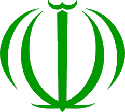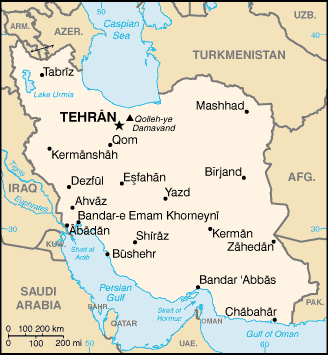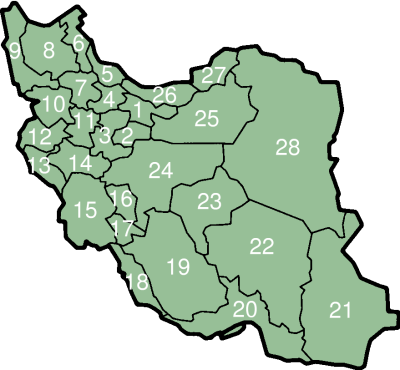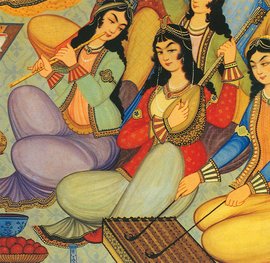Iran
|
|
Iran (historically Persia) (Persian: ایران) is a Middle Eastern country located in Southwest Asia. Although locally known as Iran from the ancient times, until 1935 the country was referred to in the West as Persia. In 1959 Mohammad Reza Shah Pahlavi announced that both terms could be used. Use of the word "Persia" to refer to present-day Iran is, however, rare. The name Iran is a cognate of "Aryan" meaning "Land of the Aryans".
Iran borders Azerbaijan (length of border: 500 km) and Armenia (35 km) to the northwest the Caspian Sea to the north, Turkmenistan (1000 km) to the northeast, Pakistan (909 km) and Afghanistan (936 km) to the east, Turkey (500 km) and Iraq (1458 km) to the west, and finally the waters of the Persian Gulf and the Gulf of Oman to the south. In 1979 a revolution led by the Ayatollah Khomeini established a theocratic Islamic Republic making the present full name of the country The Islamic Republic of Iran (جمهوری اسلامی ایران).
| ||||
| National motto: —'Independence, Freedom, The Islamic Republic' 'esteghlâl, âzâdi, jomhoorie eslâmi' (Persian) | ||||
| Missing image LocationIran.png image:LocationIran.png | ||||
| Official language | Persian | |||
| Capital | Tehran | |||
| Supreme Leader | Ali Khamenei | |||
| President | Mohammad Khatami | |||
| Area - Total - % water | Ranked 17th 1,648,195 km² 0.7% | |||
| Population - Total (July 2004) - Density | Ranked 18th 69,018,924 42/km² | |||
| Currency | Rial | |||
| Time zone | GMT +3.30 | |||
| National anthem | Sorood-e Melli-e Jomhoori-e Eslami | |||
| Internet TLD | .ir | |||
| Calling Code | 98 | |||
| Contents |
History
Main article: History of Iran
Iran traces its national origin to Persia, an empire that emerged in the 6th century BCE under the Achaemenid dynasty. This vast empire controlled areas from present day Greece to northwestern India. Indeed, the name Persia is derived from Persis, the ancient Greek name for the empire. Alexander the Great conquered Persia (on his third attempt), but soon after Persia regained its independence in the form of the Parthian and Sassanid Empires. The latter was defeated by the Islamic Arab forces in the 7th century.
The 16th century saw renewed independence with the Safavids and then other lines of kings or shahs. During the 19th century Persia came under pressure from both Russia and the United Kingdom leading to a process of modernisation that continued into the 20th century. By the 20th century Iranians were longing for a change and thus followed the Persian Constitutional Revolution of 1905/1911. In 1953 Iran's prime minister Mohammed Mossadeq, who had been elected to parliament in 1923 and again in 1944 and who had been prime minister since 1951, was removed from power in a complex plot orchestrated by British and US intelligence agencies ("Operation Ajax"). Many scholars suspect that this ouster was motivated by British-US opposition to Mossadeq's attempt to nationalize Iran's oil. Following Mossadeq's fall, Shah Mohammad Reza Pahlavi (Iran's monarch) grew increasingly dictatorial. With strong support from the USA and the UK, the Shah further modernised Iranian industry but crushed civil liberties. His autocratic rule, including systematic torture and other human rights violations, led to the Iranian revolution and overthrow of his regime in 1979. After more than a year of political struggle between a variety of different groups, an Islamic republic was established under the Ayatollah Khomeini by popular vote.
The new theocratic political system instituted some conservative Islamic reforms and engaged in an anti-Western course. In particular Iran distanced itself from the United States due to the American involvement in the 1953 coup, which supplanted an elected government with the Shah's repressive regime. The new government inspired various groups considered by a a large part of the Western World to be fundamentalist. As a consequence many countries, currently led by the USA, consider Iran to be a hostile power.
In 1980 Iran was attacked by neighbouring Iraq and the destructive Iran-Iraq War continued until 1988. However, in more recent years, the democratic political structure has led to the election of many reformist politicians including the president, Mohammad Khatami. The struggle between reformists and conservatives over the future of the country continues today through electoral politics.
See also: full list of Iranian Kingdoms
Politics
Azadidown.jpg
Introduction
Iran is a constitutional Islamic Republic, whose political system is laid out in the 1979 constitution called Qanun e Asasi. Iran's makeup has several intricately connected governing bodies, some of which are democratically elected and some of which operate by co-opting people based on their religious inclinations.
The Supreme Leader (Rahbar)
According to Iran's Constitution (http://www.salamiran.org/IranInfo/State/Constitution/), the Supreme Leader of Iran is responsible for the delineation and supervision of "the general policies of the Islamic Republic of Iran." In the absence of a single leader, a council of religious leaders is appointed. The Supreme Leader is commander-in-chief of the armed forces and controls the Islamic Republic's intelligence and security operations; he alone can declare war. He has the power to appoint and dismiss the leaders of the judiciary, the state radio and television networks, and the supreme commander of the Islamic Revolutionary Guard Corps. He also appoints six of the twelve members of the Council of Guardians. He, or the council of religious leaders, are elected by the Assembly of Experts, on the basis of their qualifications and the high popular esteem in which they are held.
The President (Ra'is-e Jomhour)
After the office of Leadership, the President of Iran is the highest official in the country. His is the responsibility for implementing the Constitution and acting as the head of the executive, except in matters directly concerned with (the office of) the Leadership. According to the law, all presidential candidates must be approved by the Council of Guardians prior to running, after which he is elected by universal suffrage to a 4-year term by an absolute majority of votes. After his election, the president appoints and supervises the Council of Ministers (the cabinet), coordinates government decisions, and selects government policies to be placed before the parliament. Eight vice presidents serve under the president, as well as a cabinet of 21 ministers. The Council of Ministers must be confirmed by Parliament. Unlike many other states, the executive branch in Iran does not control the armed forces.
The Parliament (Majles)
Iranparliament.jpg
The unicameral Iranian parliament, the Islamic Consultative Assembly or "Majles-e Shura-ye Eslami", consists of 290 members elected to a 4-year term. The members are elected by direct and secret ballot. It drafts legislation, ratifies international treaties, and approves the country's budget. All legislation from the assembly must be reviewed by the Council of Guardians. Candidates for a seat in the Majles require approval by the Council of Guardians.
The Assembly of Experts
The Assembly of Experts, which meets for one week every year, consists of 86 "virtuous and learned" clerics elected by the public to eight-year terms. Like presidential and parliamentary elections, the Council of Guardians determines eligibility to run for a seat in this assembly.
Members of the Assembly of Experts in turn elect the Supreme Leader from within their own ranks and periodically reconfirm him. The assembly has never been known to challenge any of the Supreme Leader's decisions.
The Council of Guardians
Twelve jurists comprise the Council of Guardians, six of whom are appointed by the Supreme Leader. The head of the judiciary recommends the remaining six, which are officially appointed by Parliament.
The Council of Guardians is vested with the authority to interpret the constitution and determines if the laws passed by Parliament are in line with sharia (Islamic law). Hence the council can exercise veto power over Parliament. If a law passed by Parliament is deemed incompatible with the constitution or sharia, it is referred back to Parliament for revision.
The council also examines presidential and parliamentary candidates to determine their fitness to run for a seat.
The Expediency Council
Created by Ayatollah Khomeini in 1988, the Expediency Council has the authority to mediate disputes between Parliament and the Council of Guardians. Presently, according to the constitution, the Expediency Council serves as an advisory body to the Supreme Leader, making it one of the most powerful governing bodies in the country, at least in name.
The Judiciary
The head of the judiciary is appointed by the Supreme Leader, who in turn appoints the head of the Supreme Court and the chief public prosecutor.
Public courts deal with civil and criminal cases. There are also revolutionary courts that try certain categories of offenses, including crimes against national security, narcotics smuggling, and acts that undermine the Islamic Republic. Decisions rendered in revolutionary courts are final and cannot be appealed.
The rulings of the Special Clerical Court, which functions independently of the regular judicial framework and is accountable only to the Supreme Leader, are also final and cannot be appealed. The Special Clerical Court handles crimes allegedly committed by clerics, although it has also taken on cases involving lay people.
Geography
Main article: Geography of Iran
Iran's landscape is dominated by rugged mountain ranges that separate various basins or plateaus from one another. The populous western part is the most mountainous, with ranges such as the Zagros and Alborz Mountains, the latter of which also contains Iran's highest point, the Damavand at 5,607 m. The eastern half consists mostly of uninhabited desert basins with the occasional salt lake.
The only large plains are found along the coast of the Caspian Sea and at the northern end of the Persian Gulf, where Iran borders on the mouth of the Arvand river (Shatt al-Arab). Smaller, discontinuous plains are found along the remaining coast of the Persian Gulf, the Strait of Hormuz and the Sea of Oman. The Iranian climate is mostly arid or semiarid, though subtropical along the Caspian coast. Iran is considered to be one of the fifteen states that comprise the so-called "Cradle of Humanity".
See also: List of cities in Iran.
Economy
Main article: Economy of Iran
The economy is a mixture of central planning, state ownership of oil and other large enterprises, village agriculture, and small-scale private trading and service ventures. The current administration has continued to follow the market reform plans of the previous one and has indicated that it will pursue diversification of Iran's oil-reliant economy. Iran is attempting to diversify by investing revenues in other areas, including petrochemicals. Iran also is hoping to attract billions of dollars worth of foreign investment by creating a more favorable investment climate (i.e., reduced restrictions and duties on imports, creation of free-trade zones).
Iranmoney.jpg
The services sector has seen the greatest long-term growth in terms of its share of GDP, but the sector remains volatile. State investment has boosted agriculture, however, with the liberalisation of production and the improvement of packaging and marketing helping to develop new export markets. Large-scale irrigation schemes, together with the wider production of export-based agricultural items such as dates, flowers and pistachios, produced the fastest economic growth of any sector in Iran over much of the 1990s, although successive years of severe drought in 1998, 1999, 2000, and 2001 have held back output growth substantially. Agriculture remains one of the largest employers, accounting for 22% of all jobs according to the 1991 census.
Demographics
Main article: Demographics of IranThe majority of Iran's people speak one of the Iranian languages, though only Persian is an official language. While the number, percentage, and definition of the different Iranian peoples is disputed, the major ethnic groups in Iran are Persians (51%), Azerbaijan Turks (24%), Gilaki and Mazandarani (8%), Kurds (7%), Arabs (3%), Baluchi (2%), Lurs (2%), Turkmen Turks (2%), Qashqai Turks, Armenians, Jews, Assyrians and others.¹
Most Iranians are Muslims; 89% belong to the Shia branch of Islam, the official state religion, and about 10% belong to the Sunni branch, which predominates in most Muslim countries. Non-Muslim religious minorities include the Bahá'í Faith, Zoroastrians, as well as Jews and Christians. The latter three are officially recognised minority religions and have reserved seats in parliament. Iran's population size increased dramatically in the latter part of the 20th century.
¹ Please note that the numbers are according to 2004 edition of CIA's The World Factbook. Different claims include higher numbers for Persians and a respectively lower numbers for Turkic peoples or a higher number for Turkic speaking peoples. Some people in the first group claim that the CIA statistics are based on guesses made around 1964, while CIA claims that the edition is based on January 2004 information.
Provinces
Main article: Provinces of Iran
Iran consists of 30 provinces (ostan-haa, singular form: ostan):
Culture
Main article: Culture of Iran
Like all ancient civilizations, culture constitutes the focal point and heart of the Iranian civilization. The art, music, architecture, poetry, philosophy, traditions, and ideology of this land is what makes the Iranian a proud citizen of the global village. In fact, Iranians believe their culture to be the one and only reason why their civilization has continuously survived thousands of years of plethoric calamities.
- Ey Iran
- full list of Iranian Kingdoms
- List of famous Iranians
- Music of Iran
- Higher education in Iran
- List of universities in Iran
- Islam in Iran
- Iranian Architecture
- Persian rugs
- Persian Gardens
- Persian language
- Persian Women
- List of all things Persian
- Iranian languages
- List of Iranian scientists of the pre-modern age.
- List of Iranian scientists and engineers of the modern age.
- Major cities in Iran
Miscellaneous topics
- U.S.-Iran relations
- Iran-Contra Affair
- Iran-Iraq War
- Parthia
- Iran-Israel relations
- Iranian Blogs
- Internet censorship in Iran
- Communications in Iran
- Ethnic minorities in Iran
- Football in Iran
- Foreign relations of Iran
- Holidays in Iran
- Iran's nuclear program
- Iran and weapons of mass destruction
- List of Iranians
- Iranian Media
- Military of Iran
- Persian
- Religious Minorities
- Transportation in Iran
- White Revolution
Official Government Links
The following websites belong to the various branches of government, or are directly operated by the government of the Islamic Republic of Iran:
- Official site of the Supreme Leader (http://www.leader.ir), (Qom office) (http://www.wilayah.org/)
- Presidency of the Islamic Republic of Iran (http://www.president.ir) - Official website.
- The Council of Guardians (http://www.irisn.com/), Official website.
- The Majlis (http://mellat.majlis.ir/), Iran's parliament. (2) (http://www.majlis.ir/).
- The Judiciary of The Islamic Republic of Iran (http://www.iranjudiciary.org/)
- Ministry of Foreign Affairs (http://www.mfa.gov.ir)
- Ministry of Science, Research and Technology (http://www.msrt.ir/)
- Ministry of Health and Medical Education (http://www.hbi.dmr.or.ir)
- Ministry of Agriculture (http://www.agri-jahad.org)
- Ministry of Culture and Islamic Guidance (http://www.ershad.gov.ir/)
- Ministry of Commerce (http://www.irancommerceministry.com/)
- Ministry of Energy (http://www.moe.org.ir/)
- Ministry of Petroleum (http://www.nioc.org/)
- Ministry of Housing and Urban Development (http://www.hud.ir/)
- Ministry of Industry and Mines (http://www.mim.gov.ir/)
- Ministry of Defense and Armed Forces (http://www.mod.ir/)
- Ministry of Roads and Transportation (http://www.mrt.ir/New/Main.asp)
- Ministry of Labour and Social Affairs (http://www.irimlsa.ir)
- Ministry of Interior (http://www.moi.ir/)
- Ministry of Information and Communication Technology (http://www.dci.ir/), (2) (http://www.iranpac.net.ir/)
- Ministry of Cooperation (http://www.icm.gov.ir/)
- Ministry of Education (http://213.176.19.4/medu/index.aspx)
- Ministry of Economic and Finance Affairs (http://www.mefa.gov.ir/)
- Secretariat of The High Council of Iran Free Trade Industrial Zones (http://www.freezones.ir/)
- Secretariat of The High Council of The Cultural Revolution (http://www.iranculture.org)
- Official Spokesman of the Islamic Republic of Iran (http://www.spk-gov.ir/)
- Islamic Republic of Iran Atomic Energy Organization (http://www.aeoi.org.ir/)
- Islamic Republic of Iran Police Forces (http://www.police.ir/)
- Islamic Republic of Iran Academy of The Arts (http://www.honar.ac.ir/)
- Islamic Republic of Iran Geological Survey Organization (http://www.gsi-iran.org/)
- Islamic Republic of Iran Management and Planning Organization (http://www.mporg.ir/)
- Islamic Republic of Iran Organization of Welfare (http://www.behzisty.org)
- Islamic Republic of Iran National Youth Organization (http://www.nyoir.org)
- Islamic Republic of Iran Judiciary Public Relations Bureau (http://www.irjpr.com/)
- Islamic Republic of Iran Center for Affairs of Women's Participation (http://www.women.org.ir/)
- Islamic Republic of Iran Academy of Medical Sciences (http://www.ams.ac.ir/)
- Islamic Republic of Iran Cultural Heritage Organization (http://www.iranmiras.ir/)
- Islamic Republic of Iran Headquarters for Combating Drugs (http://www.dchq.ir/)
- Islamic Republic of Iran Academy of Persian Language and Literature (http://www.persianacademy.ir/)
- Islamic Republic of Iran Department of Environment (http://www.irandoe.org/)
- Islamic Republic of Iran International Center for Diologue Among Civilizations (http://www.dialoguecentre.org/)
- Islamic Republic of Iran Red Crescent Society (http://www.rcs.ir/en)
- Islamic Republic of Iran Physical Education Organization (http://www.sport.ir/)
- Islamic Republic of Iran Academy of Sciences (http://www.ias.ac.ir/)
- Islamic Republic of Iran Broadcasting (http://www.irib.com), official website.
- Central Bank of the Islamic Republic of Iran (http://www.cbi.ir/)
- Bonyad e Shahid Foundation (http://www.shahid.ir/)
- Bonyad e Mostazafeen Foundation (http://www.iran-bonyad.com/)
External links
- Template:Wikitravel
- Iran Travel and Tourism Guide (http://www.irpedia.com/)
- Encyclopaedia Iranica (http://www.iranica.com)
- Iranian Cultural & Information Center (http://tehran.stanford.edu/) at Stanford University, California
- CIA World Factbook - Iran (http://www.cia.gov/cia/publications/factbook/geos/ir.html)
- Library of Congress - Country Studies: Iran (http://lcweb2.loc.gov/frd/cs/irtoc.html) data as of May 1988
- LookSmart - Iran (http://search.looksmart.com/p/browse/us1/us317916/us559898/us560105/us560110/) directory category
- Open Directory Project - Iran (http://dmoz.org/Regional/Middle_East/Iran/) directory category
- Yahoo! - Iran (http://dir.yahoo.com/Regional/Countries/Iran/) directory category
- Yahoo! News Full Coverage Iran (http://news.yahoo.com/fc?tmpl=fc&cid=34&in=world&cat=iran) headline links
- HavenWorks' Iran News (http://www.havenworks.com/world/iran)
- Directory of Iranian online newspapers (http://www.gooya.com)
- http://www.iran-now.com News and Community Portal
- Iran Oil and Gas (http://www.iranoilgas.com/)
- Freedom of Expression in Iran (http://www.ifex.org/en/content/view/full/221/) - IFEX
- List of alleged weapons (http://cns.miis.edu/research/wmdme/iran.htm)
- The Dismal Reality of Ahlus Sunnah in Iran (http://www.islam.org.au/articles/24/iran.htm)
- Iran, The Persian Gulf (http://www.thepersiangulf.org) - Iran in the Persian Gulf
- List of Iranian High Commissions, embassies and consulates (http://www.irpedia.com/iran/touristinfo.php?ID=1203) around the world.
- The Iran Elections (http://www.foreignpolicy.com/story/cms.php?story_id=2864) - A guide to understanding the Iranian elections
| Countries and Territories in Southwest Asia |
|
Afghanistan | Armenia | Azerbaijan | Bahrain | Cyprus | Gaza Strip | Georgia | Iran | Iraq | Israel | Jordan | Kuwait | Lebanon | Oman | Qatar | Russia | Saudi Arabia | Syria | Turkey | United Arab Emirates | West Bank | Yemen |
| Countries and territories in the Middle East |
|---|
| Bahrain | Cyprus | Egypt | Gaza Strip | Iran | Iraq | Israel | Jordan | Kuwait | Lebanon | Oman | Qatar | Saudi Arabia | Syria | Turkey | United Arab Emirates | West Bank | Yemen |
ast:Irán ca:Iran cs:Írán cy:Iran da:Iran de:Iran et:Iraan es:Irán eo:Irano fa:ایران fr:Iran gl:Irán - ایران ko:이란 hi:ईरान hr:Iran io:Iran id:Iran it:Iran he:איראן ku:Îran li:Iraan lv:Irāna lt:Iranas ms:Iran zh-min-nan:Iran nl:Iran nds:Iran ja:イラン nb:Iran nn:Iran oc:Iran pl:Iran pt:Irão ro:Iran ru:Иран simple:Iran sk:Irán sl:Iran sr:Иран fi:Iran sv:Iran th:ประเทศอิหร่าน tr:İran uk:Іран zh:伊朗






